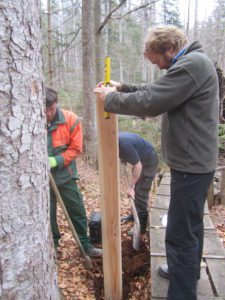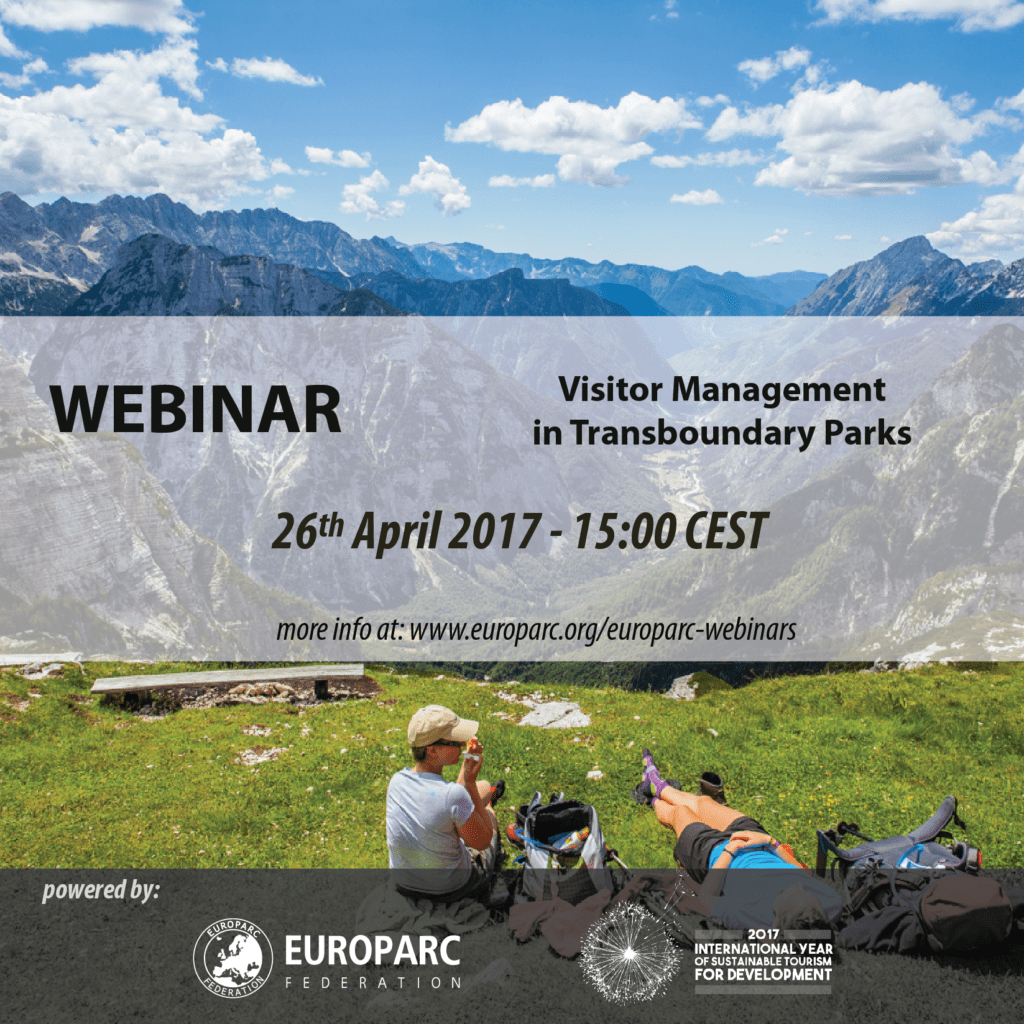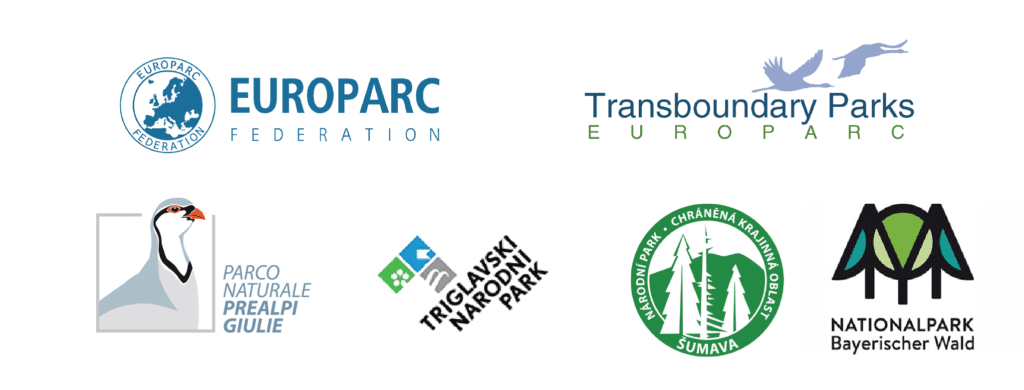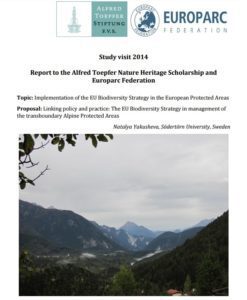Counted – asked – observed: On the tracks of national park visitors
In the Bavarian Forest National Park exist around 500 km of marked trails, but they differ extremly in intensity of use according to their destination and location. (Photo: Maria Husslein)
Article issued by Maria Husslein extracted from Protected Areas In-Sight 2016 “We are Parks”
Maria Husslein works in the administration of the Bavarian Forest National Park Administration since 2007 and is in charge of visitor management.
Large protected areas like national parks are popular destinations, welcoming every year thousands of curious visitors, families, schools and people passionate about wildlife. One of the main challenges today for the management of national parks, is making the park accessible for visitors’ recreation in accordance with the park´s main aim – leaving nature to nature.
As a fact, active, instead of reactive visitor management avoids conflicts and assures long-term satisfaction among the visitors. At the same time, active management imposes restrictions to avoid affecting ecological processes. Three years ago, we have established in the Bavarian Forest National Park a system for monitoring visitors. The first challenge was the selection of the best locations to collect data as the National Park has very many entrances. To identify them, a set of criteria was established, through the organisation of several workshops with the Park Rangers.

With the help of heat sensors, which are disguised as signposts, the number of visitors was captured on important trails over a year’s time. (Photo: ILEN/BOKU)
We installed 15 mechanical counters in 14 places during 12 days (statistically distributed over one year) and over 60 places where observers were counting visitors. Nearly 1.3 million visitors were counted during a twelve-month period and about 1,000 surveys were made at the entrances of the National Park. The results are quite interesting, and reveal the motivation of our visitors:
- Almost all respondents knew they were in a protected area.
- Around 85 % were aware of this protected area being a national park.
- Around 60% considered the status of national park a very important factor for their decision to visit the area.
- What visitors most appreciate about the national park are the “nature or untouched nature”, the “serenity”, the “hiking paths” and the “signposting” (in the form, there were no predefined answers).
After the 1st study, we defined 4 relevant sites for data collection. Regular repetitions of surveys will be done, to identify new trends in the composition of visitors in their perception of the national park.
Cross-border cooperation
Our neighboring Park in Czech Republic, Šumava National Park, with whom we have been collaborating since 2009 within the framework of EUROPARC’s Transboundary Parks Programme, is also aware of the importance of socioeconomic monitoring. Currently, we are looking to replicate the monitoring system in Šumava. If successful, the Czech Ministry might also replicate the process in all 4 Czech National Parks.
If compatible data were available, a sustainable, cross-border tourism strategy could make a leap forward!
___________________________________________________________________________
Join EUROPARC Webinar
On the 26th April, we will be hearing in the first person more information about the cross-border cooperation between the Bavarian Forest and Šumava National Parks, in a special webinar dedicated to visitor management in Transboundary Parks! Register today!


Linking policy and practice: The EU Biodiversity Strategy in the management of Transboundary Protected Areas
Triglav National Park © Triglav NP archive
Linking policy and practice: The EU Biodiversity Strategy in the management of Transboundary Alpine Protected Areas
Article issued by Natalya Yakusheva
Every year, the Alfred Toepfer Natural Heritage Scholarship supports the work of young conservationist in protected areas across Europe. Natalya was one of the winners of the Scholarship in 2014.
Biodiversity loss is one of the most severe environmental problems that spans from local to global levels. Consequently, the measures tackling this problem include wide range of political instruments, scientific research, and local actions. However, it is not always easy to trace a link between often abstract political objectives and applied measures.
Natalya Yakusheva conducted her study visit in the Transboundary Julian Alps Ecoregion, which includes Prealpi Giulie Nature Park in Italy and Triglav National Park in Slovenia, to explore the links between the European Union’s and national political objectives for nature conservation, and the day-to-day implementation and management practices in these protected areas.
During a month-long visit, Natalya conducted interviews with park employees, local stakeholders, and scientists, as well as participated in various workshops and field activities in both parks.
How to bridge biodiversity concerns and local communities’ expectations?
The process of designation of protected areas in both countries brought certain dissatisfaction among local stakeholders, who often claim conservation limits the development of different activities. In response to these concerns, the park administration’s work to further develop sustainable tourism and support nature-friendly local agricultural practices to improve local livelihoods.

Sheep grazing in the Prealpi Giulie Nature Park © Natalya Yakusheva
Since 1996, Parks have been cooperating under the framework of the Transboundary Parks Programme, with joint efforts in the fields of conservation, research, education, and rural development. Moreover, in 2016, they have also applied the methodology of the European Charter for Sustainable Tourism in Protected Areas (ECST), becoming the first cross-border Sustainable Destination in Europe. Through the application of the ECST, Parks developed a permanent forum of stakeholders and defined a 5-year action plan, aiming to maximise the socio-economic benefits to their local communities, whilst preserving its natural assets.
Moreover, Parks seek to attract diversified funding for conservation and local development through EU-funded programmes, that allows them to closer engage with the local communities and bring them higher benefits. Despite existing difficulties, they seek to closely engage in the local development processes and keep in contact with relevant stakeholders locally, nationally and internationally.
The parks seek to closely engage in environmental education and extra activities for kids and youngsters from the park municipalities as a way to promote conservation agenda and build a solid foundation among those who will define the face of this area in the years ahead.

Excursion of school kids from Resia municipality, Italy to Nockberge UNESCO MAB, Austria, organised by the Prealpi Giulie park administration © Natalya Yakusheva
Conclusions
The findings of the study visit demonstrated that day-to-day practices of the park administrations are in line with major objectives of the European approach, especially, in regards to public engagement and ways to balance nature conservation and local sustainable development in practice. The latter was recognised both on a formal level, through the inclusion into Management Plans of both parks, and informal level, as the importance of this was acknowledged by interviewees from both sides of the border.
The recognition of these common ways of working for the park and local communities is the first step towards successful long-term policy implementation that brings benefits for nature and for people.
Download the full report here
More on the EU biodiversity political and legal framework:
The Directive on the Conservation of Wild Birds 79/409/EEC
The Directive on the Conservation of Natural Habitats and of Wild Fauna and Flora 92/43/EEC
The Natura 2000 network of protected areas
The call for the Alfred Toepfer Natural Heritage Scholarship 2017 is still open!
If are under 35 and would like to conduct a study tour to European Protected Areas, then this is the perfect opportunity for you. Applications are open to all geographic Europe, for students and staff working for a PA or environmental NGO.
Submit your project application before the 28th April.
“One Site, One Plan. Integrated Conservation Management”
Eurosite workshop
Amersfoort, the Netherlands, 7-8 June 2017
Eurosite, together with Natuurmonumenten, Staatsbosbeheer and Natural England are organising a workshop to share a new approach to the management of conservation sites. The Dutch and UK national conservation organisations have been working closely together on this approach that:
- It is adaptive and integrates planning, implementation, monitoring and evaluation;
- It is scalable, integrating the management of individual sites with the management of site networks;
- It harmonises conflicting interests by integrating all land interests into a single, dynamic site plan;
- It is software supported, integrating mapping, data and documents to create a one-stop information system;
- It shares learning enabling organisations to integrate information from other sites and into their site management.
The approach has been adopted on over 1,000 sites managed by public and charitable sector organisations, who will now share the benefits and challenges of this evolving approach. During the conference there will be presentations from practitioners, practical workshops and site visits to see how it works in the field on Natura 2000 and other sites.
Above all, the conference was designed for delegates to share their ‘real-world’ practical experiences (the good and the bad) of adaptive management so participants can take home new ideas for their organisations and nature sites.
Who should attend?
Anyone with working in the field of conservation, in particular: site managers, site planners, responsible conservation staff members, habitat and species surveyors, information management specialists and ICT managers.
For more information, please visit Eurosite website:
http://eurosite.org/events/eurosite-workshop-one-site-one-plan-integrated-conservation-management/
Course of Photographic Activities in Protected Spaces – EUROPARC Spain
EUROPARC Spain and Fernando González Bernáldez Foundation have open the registrations for the 2017 edition of the
Course of Photographic Activities in Protected Spaces
This course offers both a reflection and practical aspects of the great potential that photography has as a tool for the conservation and communication of nature in protected areas. The course aims to give to the participants the ability to design and implement basic activities in photography through which they can contribute to the multiple objectives of protected natural spaces.
Registrations are open until 5th of May. The course will be taught in Spanish language either through a combination of face-to-face and online classes, or completely online, and will take place from the 16th of May to the 11th of June 2017. The face-to-face sessions are scheduled for the 29th and 30th of May and will take place in Madrid.
Reduced fees for students and unemployed are available, as well as for technicians of the administrations of EUROPARC-Spain. Discounts can be obtained through the Tripartite Foundation.
The course counts with the collaboration of the Spanish Association of Nature Photographers, AEFONA, and the Photography and Biodiversity Association.
Get further information and registrations, and a course brochure at the Fernando González Bernáldez Foundation website.
